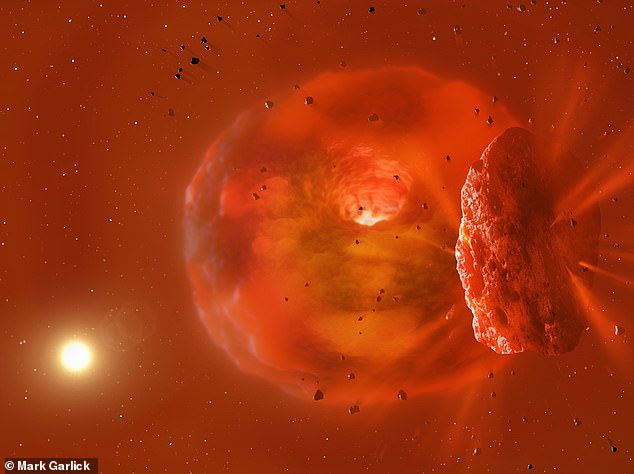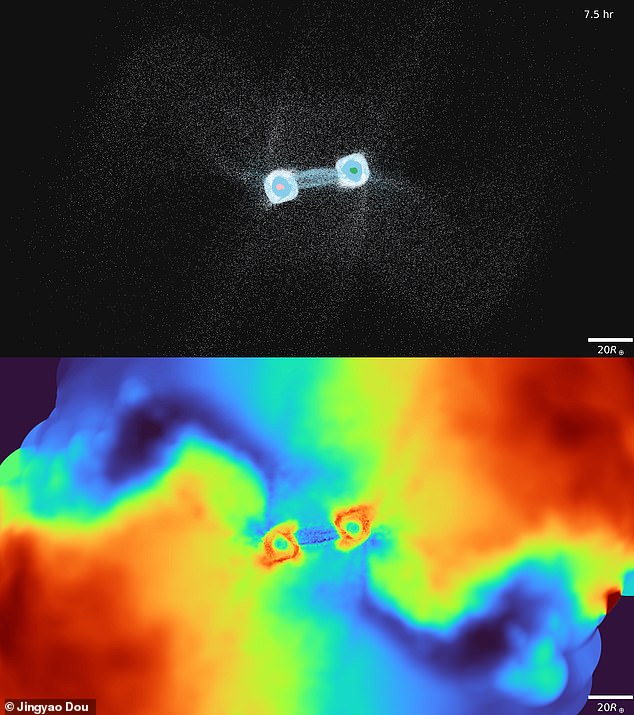Incredible image reveals the moment two icy exoplanets COLLIDED 1,800 light-years away – releasing an enormous cloud of dust
>
- This is the first time that astronomers have captured the aurora resulting from the collision of planets in space
- It was discovered by chance after an amateur astronomer spotted the oddity in a social media post
This stunning image depicts the moment two icy exoplanets collided with each other 1,800 light-years away in a cosmic collision that had only been observed by chance.
This astonishing discovery represents the first time astronomers have captured the aurora resulting from a planetary collision in outer space.
It was discovered after the two giant exoplanets collided with each other around a sun-like star, creating a flare of light and spewing out massive plumes of dust.
The latter is what proved to be the key to its discovery, along with the help of an amateur astronomer who spotted something strange in a social media post.
While studying the light curve of the parent star, the enthusiast noticed that the brightness of the system had doubled about three years ago, before it began to fade over time.

OUT OF THIS WORLD: This stunning image depicts the moment two icy exoplanets collided with each other 1,800 light-years away in a cosmic collision that was only observed by chance.
It turned out that this dimming was caused by the dust cloud resulting from the collision of planets.
“To be honest, this observation was a complete surprise to me,” said Dr. Matthew Kenworthy, co-author of the new study from Leiden University in the Netherlands.
“When we originally shared the visible light curve of this star with other astronomers, we began viewing it using a network of other telescopes.
An astronomer pointed out on social media that the star shone in infrared rays over a period of a thousand days before visual fading.
“I knew then that this was an unusual event.”
Once they were informed of it, a network of professional and amateur astronomers studied the star closely to monitor how its brightness changed over a period of two years.
The star ASASSN-21qj is named after the network of telescopes that first detected the star’s fading at visible wavelengths.
The researchers came to the conclusion that the most likely explanation for this fading star is that two icy giant exoplanets collided with each other and produced the infrared glow detected by NASA’s NEOWISE mission.
This is a space telescope that hunts for near-Earth asteroids and comets.
Co-author Dr Simon Locke, from the University of Bristol, said: ‘Our calculations and computer models indicate the temperature and volume of the glowing material, as well as the amount of time the glow lasted, is consistent with the collision of two objects.’ Ice giant exoplanets.
About three years after the flare was detected, the dust cloud resulting from the impact finally passed in front of ASASSN-21qj.
This is what causes the star’s brightness to dim at visible wavelengths.

Amazing: This astonishing discovery was the first time astronomers had captured the aurora resulting from a planetary collision in outer space. Computer simulations depict the two icy giant planets colliding with each other (above), along with what the intense heat and bright vapor would look like, shown in different colors.
Astronomers are now keen to monitor the system closely over the following years to see what will happen next.
They say the dust cloud is expected to begin to recede, at which point the scattering of light could be detected by NASA’s James Webb Space Telescope and ground-based observatories on Earth.
The material could eventually become a number of moons orbiting the parent star ASASSN-21qj.
Co-author Dr Zoe Linhardt, from the University of Bristol, said: “It would be great to monitor further developments.”
“Eventually, the mass of material may condense around the remnant to form a retinue of moons that will orbit this new planet.”
The new discovery was revealed in a study published in the journal nature.
(Tags for translation)dailymail

